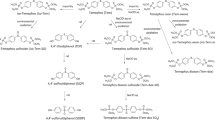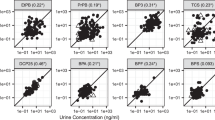Abstract
The objective of this study was to evaluate the quantitative relation between measured red blood cell acetylcholinesterase (RBC AChE) and plasma butyrylcholinesterase (BuChE) activities with exposure to chlorpyrifos (CPF) as assessed by measurement of urinary 3,5,6-trichloro-2-pyridinol (TCPy) in a study group of workers occupationally exposed in the manufacture of CPF and a referent group of chemical manufacturing workers. Measures of plasma BuChE and RBC AChE activity and urinary TCPy concentration collected over a year-long study (1999–2000) in CPF-exposed workers (n=53) and referents (n=60) were analyzed using linear mixed models to characterize exposure–response relationships. Intraindividual variability in cholinesterase measures was compared between CPF-exposed workers and referents. Urinary TCPy concentrations in CPF workers were substantially elevated compared to referents, with median and 95th percentile concentrations during typical employment conditions 10-fold and more than 30-fold higher, respectively, than corresponding measures in the referents. Intraindividual variability in cholinesterase activities was substantial, with 17% of unexposed referents experiencing one or more plasma BuChE measures more than 20% below baseline over a year of repeated, periodic measurements. RBC AChE activity, an early biomarker of effect, was unrelated to urinary TCPy concentration over the entire range of exposure, up to 1000 μg TCPy/g creatinine (Cr). Plasma BuChE activity, a non-adverse biomarker of exposure, was negatively related to urinary TCPy concentrations above approximately 110 μg TCPy/g Cr. No-effect levels for inhibition of plasma BuChE and RBC AChE corresponding to absorbed doses of CPF of approximately 5 and greater than 50 μg/kg/day, respectively, were identified. These findings are consistent with previous no-effect level determinations for ChE inhibition in humans and suggest that general population CPF exposure levels are substantially below the identified no-effect levels. The dose–response relationships observed in this study are consistent with predictions from the previously published physiologically based pharmacokinetic/pharmacodynamic model for CPF. Intraindividual variability in measured cholinesterase activities in referents was substantial, suggesting that ongoing monitoring programs may have a substantial rate of false positives.
This is a preview of subscription content, access via your institution
Access options
Subscribe to this journal
Receive 6 print issues and online access
$259.00 per year
only $43.17 per issue
Buy this article
- Purchase on Springer Link
- Instant access to full article PDF
Prices may be subject to local taxes which are calculated during checkout





Similar content being viewed by others
References
Agency for Toxic Substances and Disease Registry (ATSDR). Toxicological Profile for Chlorpyrifos. US Department of Health and Human Services, Public Health Service, Atlanta, GA, 1997.
Albers J.W., Berent S., Garabrant D.H., Giordani B., Schweitzer S.J., Garrison R.P., et al. The effects of occupational exposure to chlorpyrifos on the neurologic examination of central nervous system function: a prospective cohort study. J Occup Environ Med 2004a: 46 (4): 367–378.
Albers J.W., Garabrant D.H., Mattsson J.L., Burns C.J., Cohen S.S., Sima C., et al. Dose–effect analyses of occupational chlorpyrifos exposure and peripheral nerve electrophysiology. Toxicol Sci 2007: 97 (1): 196–204.
Albers J.W., Garabrant D.H., Schweitzer S., Garrison R.P., Richardson R.J., and Berent S. Absence of sensory neuropathy among workers with occupational exposure to chlorpyrifos. Muscle Nerve 2004b: 29 (5): 677–686.
Albers J.W., Garabrant D.H., Schweitzer S.J., Garrison R.P., Richardson R.J., and Berent S. The effects of occupational exposure to chlorpyrifos on the peripheral nervous system: a prospective cohort study. Occup Environ Med 2004c: 61 (3): 201–211.
Alexander B.H., Burns C.J., Bartels M.J., Acquavella J.F., Mandel J.S., Gustin C., et al. Chlorpyrifos exposure in farm families: results from the farm family exposure study. J Expo Sci Environ Epidemiol 2006: 16 (5): 447–456.
American Conference of Governmental Industrial Hygienists (ACGIH). Acetylcholinesterase Inhibiting Pesticides. Documentation of the BEIs. ACGIH, Cincinnati, OH, 2001.
Barr D.B., Allen R., Olsson A.O., Bravo R., Caltabiano L.M., Montesano A., et al. Concentrations of selective metabolites of organophosphorus pesticides in the United States population. Environ Res 2005: 99 (3): 314–326.
Barr D.B., and Angerer J. Potential uses of biomonitoring data: a case study using the organophosphorus pesticides chlorpyrifos and malathion. Environ Health Perspect 2006: 114 (11): 1763–1769.
Berkowitz G.S., Wetmur J.G., Birman-Deych E., Obel J., Lapinski R.H., Godbold J.H., et al. In utero pesticide exposure, maternal paraoxonase activity, and head circumference. Environ Health Perspect 2004: 112 (3): 388–391.
Burns C.J., Garabrant D., Albers J.W., Berent S., Giordani B., Haidar S., et al. Chlorpyrifos exposure and biological monitoring among manufacturing workers. Occup Environ Med 2006: 63 (3): 218–220.
Centers for Disease Control (CDC). Third National Report on Human Exposure to Environmental Chemicals. National Center for Environmental Health, Division of Laboratory Sciences, Atlanta, Georgia, 30341-3724, NCEH Pub. No. 05-0570 2005.
Coulston F., Goldberg L., and Griffin T. Safety Evaluation of Dowco 179 in Human Volunteers, Unpublished report from the Institute of Experimental Pathology and Toxicology, Albany Medical College. Albany, NY. MRID No. 00030754, 00095175 1972.
Eskenazi B., Harley K., Bradman A., Weltzien E., Jewell N.P., Barr D.B., et al. Association of in utero organophosphate pesticide exposure and fetal growth and length of gestation in an agricultural population. Environ Health Perspect 2004: 112 (10): 1116–1124.
Eskenazi B., Marks A.R., Bradman A., Harley K., Barr D.B., Johnson C., et al. Organophosphate pesticide exposure and neurodevelopment in young Mexican-American children. Environ Health Perspect 2007: 115 (5): 792–798.
Furlong C.E. Genetic variability in the cytochrome P450-paraoxonase 1 (PON1) pathway for detoxication of organophosphorus compounds. J Biochem Mol Toxicol 2007: 21 (4): 197–205.
Health Canada. Proposed Acceptability for Continuing Registration: Phase 2 of the Re-evaluation of Chlorpyrifos. Health Canada, Ottawa, Canada,PACR2003-03 2003.
Lotti M. Cholinesterase inhibition: complexities in interpretation. Clin Chem 1995: 41 (12 Part 2): 1814–1818.
Mage D.T., Allen R.H., Gondy G., Smith W., Barr D.B., and Needham L.L. Estimating pesticide dose from urinary pesticide concentration data by creatinine correction in the Third National Health and Nutrition Examination Survey (NHANES-III). J Expo Anal Environ Epidemiol 2004: 14 (6): 457–465.
Mattsson J.L., Holden L., Eisenbrandt D.L., and Gibson J.E. Reanalysis with optimized power of red blood cell acetylcholinesterase activity from a 1-year dietary treatment of dogs to chlorpyrifos. Toxicology 2001: 160 (1–3): 155–164.
Morgan M.K., Sheldon L.S., Croghan C.W., Jones P.A., Robertson G.L., Chuang J.C., et al. Exposures of preschool children to chlorpyrifos and its degradation product 3,5,6-trichloro-2-pyridinol in their everyday environments. J Expo Anal Environ Epidemiol 2005: 15 (4): 297–309.
National Research Council (NRC). Human Biomonitoring for Environmental Chemicals. Committee on Human Biomonitoring for Environmental Toxicants, Board on Environmental Studies and Toxicology, Division on Earth and Life Studies. National Academies Press, Washington, DC, 2006.
Nolan R.J., Rick D.L., Freshour N.L., and Saunders J.H. Chlorpyrifos: pharmacokinetics in human volunteers. Toxicol Appl Pharmacol 1984: 73 (1): 8–15.
Steenland K., Dick R.B., Howell R.J., Chrislip D.W., Hines C.J., Reid T.M., et al. Neurologic function among termiticide applicators exposed to chlorpyrifos. Environ Health Perspect 2000: 108 (4): 293–300.
Timchalk C., Busby A., Campbell J.A., Needham L.L., and Barr D.B. Comparative pharmacokinetics of the organophosphorus insecticide chlorpyrifos and its major metabolites diethylphosphate, diethylthiophosphate and 3,5,6-trichloro-2-pyridinol in the rat. Toxicology 2007: 237 (1–3): 145–157.
Timchalk C., Kousba A., and Poet T.S. Monte Carlo analysis of the human chlorpyrifos-oxonase (PON1) polymorphism using a physiologically based pharmacokinetic and pharmacodynamic (PBPK/PD) model. Toxicol Lett 2002a: 135: 51–59.
Timchalk C., Nolan R.J., Mendrala A.L., Dittenber D.A., Brzak K.A., and Mattsson J.L. A physiologically based pharmacokinetic and pharmacodynamic (PBPK/PD) model for the organophosphate insecticide chlorpyrifos in rats and humans. Toxicol Sci 2002b: 66 (1): 34–53.
UK ACP (United Kingdom Advisory Committee on Pesticides) Chlorpyrifos human health review: evaluation of further papers requested by the ACP, York, UK, ACP 6 (299/03) 2003.
USEPA (United States Environmental Protection Agency). Human Health Risk Assessment: Chlorpyrifos. Health Effects Division, Office of Pesticide Programs, Washington, DC, June 8 2000.
van Gemert M., Dourson M., Moretto A., and Watson M. Use of human data for the derivation of a reference dose for chlorpyrifos. Regul Toxicol Pharmacol 2001: 33 (2): 110–116.
Washington State Department of Labor and Industries. Cholinesterase Monitoring — Employer Information, www.lni.wa.gov/Safety/Topics/AtoZ/Cholinesterase/EmployerInfo.aspAccessed 9 May 2008 2008.
WHO (World Health Organization). Chlorpyrifos in Drinking Water: Background Document for Development of WHO Guidelines for Drinking-Water Quality. World Health Organization, Geneva, WHO/SDE/WSH/03.04/87 2004.
Zhao Q., Dourson M., and Gadagbui B. A review of the reference dose for chlorpyrifos. Regul Toxicol Pharmacol 2006: 44 (2): 111–124.
Zhao Q., Gadagbui B., and Dourson M. Lower birth weight as a critical effect of chlorpyrifos: a comparison of human and animal data. Regul Toxicol Pharmacol 2005: 42 (1): 55–63.
Acknowledgements
Additional investigators on this project included Richard P. Garrison, Brenda Gillespie, Bruno Giordani, Jonathon Raz (deceased), Sarah S. Cohen, Camelia Sima and other members of the Neurobehavioral Toxicology Program Chlorpyrifos Study team including Jennifer N. Baughman, Nathan Bradshaw and Zhuolin Li. We acknowledge the Dow and Dow AgroSciences employees who assisted at various points in supporting this research. Finally, we are indebted to the Dow employees who volunteered their time as subjects in this study.
Research support: This study was financially supported by Dow Agrosciences, Indianapolis, Indiana, with additional support from The Dow Chemical Company and Dow Chemical Company Foundation, which included a SPHERE (Supporting Public Health and Environmental Research Efforts) Award. Model simulations were supported by grants R01 OH003629 and R01 OH008173 from the Centers for Disease Control and Prevention (CDC). The contents of this article are solely the responsibility of the authors and have not been subject to review by CDC and therefore do not necessarily represent the official view of CDC, and no official endorsement should be inferred.
Author information
Authors and Affiliations
Corresponding author
Additional information
Disclosure
Some of the authors have received research support and at times been retained as consultants or served as expert witnesses in litigation for firms or companies, including Dow and Dow AgroSciences, concerned with the manufacture or use of insecticides. Support of these activities has included both personal and institutional remuneration.
Rights and permissions
About this article
Cite this article
Garabrant, D., Aylward, L., Berent, S. et al. Cholinesterase inhibition in chlorpyrifos workers: Characterization of biomarkers of exposure and response in relation to urinary TCPy. J Expo Sci Environ Epidemiol 19, 634–642 (2009). https://doi.org/10.1038/jes.2008.51
Received:
Accepted:
Published:
Issue Date:
DOI: https://doi.org/10.1038/jes.2008.51
Keywords
This article is cited by
-
Probabilistic health risk assessment of chlorpyrifos exposure among applicators on rice farms in Ghana
Environmental Science and Pollution Research (2021)
-
Acetylcholinesterase, Butyrylcholinesterase and Glutathione S-Transferase Enzyme Activities and Their Correlation with Genotypic Variations Based on GST M1 and GST T1 Loci in Long Term-Pesticide-Exposed Tea Garden Workers of Sub-Himalayan West Bengal
Toxicology and Environmental Health Sciences (2019)
-
Biomonitoring of chlorpyrifos exposure and health risk assessment among applicators on rice farms in Ghana
Environmental Science and Pollution Research (2018)
-
Longitudinal assessment of chlorpyrifos exposure and effect biomarkers in adolescent Egyptian agricultural workers
Journal of Exposure Science & Environmental Epidemiology (2013)
-
Paraoxonase status and plasma butyrylcholinesterase activity in chlorpyrifos manufacturing workers
Journal of Exposure Science & Environmental Epidemiology (2010)



